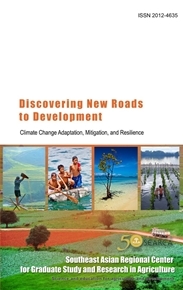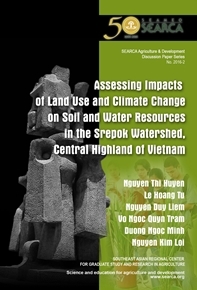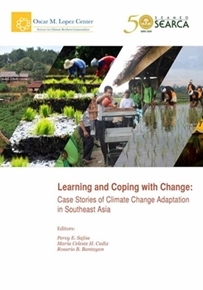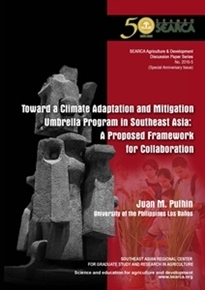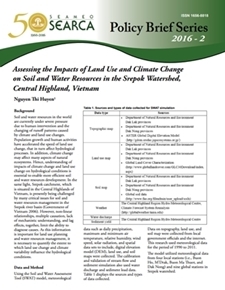SEARCA Publications
Planting native trees is vital in restoring the forest cover and its biodiversity resources. For any reforestation effort to flourish, however, people must appreciate the key role that native trees portray.
Discovering New Roads to Development Volume 4: Climate Change Adaptation, Mitigation, and Resilience
For this particular volume, due attention is given to climate change adaptation, mitigation, and resiliency because of its negative effects on the agricultural sector. Under SEARCA’s Tenth Five-Year Plan focused on Inclusive and Sustainable Agricultural and Rural Development (ISARD), climate change is flagged as a priority concern as it hinders the sector’s ability to provide food for a growing population that continues to struggle with poverty and hunger. Contents: Vulnerability Assessment of Rice Farming Provinces to Climate Change in the…
Climate change is a major global concern that greatly affects people, including their source of living. In 2010, the Asian Development Bank reported that Vietnam is one of the five countries most severely affected by climate change. About 70 percent of the country's total population lives along coastal areas and in islands. This study aimed to (1) evaluate the impacts of climate change on aquaculture in Phu Vang district (Thua Thien Hue province, Vietnam), and (2) develop a climate change adaptation model for aquaculture. Data on impact…
Capacity Assessment for Hutan Kemasyarakatan (HKm) Extension Workers in Lampung Province Strengthening Multi-stakeholder Engagement to Accelerate Social Forestry Development Linking Forest, Water, and Energy: Assessing Socio-economic and Environmental Impacts of Forest Management Development of Planning Process for Mukim Forest Recognition: Preparatory Phase Strengthening the Community Forestry Program Coordination Committee at Sub-National Level to Enhance Community Forestry Development Resource Trends Assessment and Feasibility Study on Sustainable Harvesting, Rehabilitation, and Marketing of Non-Timber Forest Products (NTFPs) in Siem Reap …
Flooding has increased in frequency in various parts of the country, causing damage to thousands of households every year. It directly affects communities through damage to livelihood and properties, loss of earning, and health hazards. Households dependent on agriculture for livelihood are particularly vulnerable because of the negative impact of flooding to productivity. Damage assessments following flood events are regularly done to determine extent of loss and to identify critical areas for intervention. However, these are often macroscale assessments, which do not necessarily generate information that could be useful for policymaking. At the municipal…
The Srepok River basin, which flows along four provinces in Vietnam and parts of Cambodia, is presently facing critical issues such as floods and droughts, pollution of waterways, deforestation of catchments, erosion and resultant sedimentation of reservoirs, overexploitation of groundwater, water-use conflicts, and transborder issues. This study aims to investigate changes in streamflow and sediment yield that result from land use changes, and climatic variation in the Srepok watershed. Plausible scenarios of land use change are simulated through Geographic Information…
The Southeast Asian Regional Center for Graduate Study and Research in Agriculture (SEARCA) is proud to present this pioneering work, featuring selected case stories on climate change adaptation initiatives that are being implemented in Southeast Asia. This book Learning and Coping with Change: Case Stories of Climate Change Adaptation in Southeast Asia is the outcome of the First Regional Knowledge Sharing Writeshop on Climate Change Adaptation (CCA) in Inclusive and Sustainable Agricultural and Rural Development (ISARD) held on 15–17 April…
Southeast Asia is highly vulnerable to climate change since a large proportion of its population is concentrated along its coastlines with livelihoods that rely on agriculture and natural resources, including fisheries and forestry. The region is annually affected by climate extremes, particularly floods, droughts, and tropical cyclones, threatening the livelihood of poor people living in rural areas who have limited adaptive capacity (IFAD 2009). Climate change in Southeast Asia is expected to lead to significant variations in precipitation patterns, increased…
This study sought to determine microscale damage estimates of the largest flood event in the history of the municipality of Jabonga in the province of Agusan del Norte. Jabonga is a lakeside municipality adjacent to Lake Mainit, the fourth largest lake in the Philippines. The study sought to determine flood-prone areas in the municipality, characterize the flood event that occurred in the site from December 2010 to March 2011, estimate actual and potential damage for different flood scenarios, and determine…
Soil and water resources in the world are currently under severe pressure due to human intervention and the changing of runoff patterns caused by climate and land use changes. Population growth and human activities have accelerated the speed of land use change, that in turn affect hydrological processes. In addition, climate change may affect many aspects of natural ecosystems. Hence, understanding of impacts of climate change and land use change on hydrological conditions is essential to enable more efficient soil…


